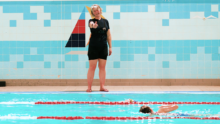
Overcoming fear and doing the 'mum stroke' - Carey's #LoveSwimming story
26/10/2019Carey Philpott has confronted one of her greatest fears in returning to the pool after an extended absence.
As she sets her sights on competing in a duathlon, Carey shares her #LoveSwimming story.
My swimming memories
When I was a child, I used to swim in a club. My eyesight started to go and I needed to wear glasses as I couldn’t see the clock to be able to know when to start during my lessons.
So I decided to give up on swimming when I was quite young, before starting secondary school.
I really don’t remember that part of my life and all of that swimming knowledge quickly faded.
Doing the ‘mum stroke’
My daughter is a great swimmer and I could get in the pool with her when she was younger, but I couldn’t swim properly.
I swam with my daughter about two years ago and she said I did a ‘mum stroke’, which meant I kept my head out of the water.
She is a competitive swimmer who is really committed and technical but I just wasn’t like that.
Finding motivation
Deciding to do the duathlon was the point I knew I needed to learn to swim.
I knew on holiday, in the pool, I could get away with doing a mum stroke.
But I wanted to do the duathlon and do it properly, so I couldn’t go into it as a rubbish swimmer.
If I can’t be good at something, then I don’t want to do it.
It wasn’t like riding a bike, the skill had just gone.
It’s been quite an emotional journey for me. The worst thing was I knew the skill and the idea – I knew my body could do it, it was all in my head.
Now I’ve reached a point where I’m quite excited to get back into the pool.
My ultimate goal is to complete the duathlon in 2020.
Learning an old trick
I went to a This Girl Can session at the local pool, where there were just women and I thought someone might be able to help me out.
It wasn’t what I was expecting – there were more retirees than younger people.
It was more about aqua aerobics and the ladies were sweet and encouraging but it wasn’t the right session for me.
I went back at a different time and I felt a bit more vulnerable. I wasn’t really prepared.
I thought it was just a matter of getting into the pool, but I had to tell myself ‘right, you can do this’.
I did a length so fast that I was out of breath and felt very flustered. My friend, who is a teacher at our local pool, said I needed to slow down and breathe.
I also took a float into the pool to help me and to try to do a ‘zip up’, which aims to get the elbow high.
Over the first few weeks, I was getting too much information for me to be able to process.
Then my friend Alan, who is my daughter’s swimming coach, helped me recognise that the issue was my fear of drowning.
I still have issues with that; I don’t like going around people and when I’m in a lane, I really have to concentrate to stay on track.
I get stressed and I really have to concentrate if there are too many people, so he coaches me from poolside and gives me support.
I swim by numbers. I was obsessed with breathing every three strokes, but I eventually realised I didn’t need to breathe that often.
I’m quite naturally sporty, so now I’m at a point of comfort and the longevity will start to come.
My message to you
This experience has given me a greater understanding of how capable I am of pushing myself through a mental barrier, which is brilliant.
I do lots of other activity, so I think combined with the physical aspect, it all compliments each other and it’s working really well.
Just acknowledge that learning to swim or getting back into the water is going to be scary.
Take it one swim at a time – I really think that’s something I have learnt.
Don’t focus on the end goal – focus on the breakdown of it.
A lot of my lessons have been about overcoming fear and improving my mentality.
I’m now going twice a week and recently completed my first 200 metre swim. This was a real fist pump moment!
If you have been inspired to swim by Carey’s story, use Swim England’s Poolfinder to locate your nearest centre.
 Just Swim
Just Swim



